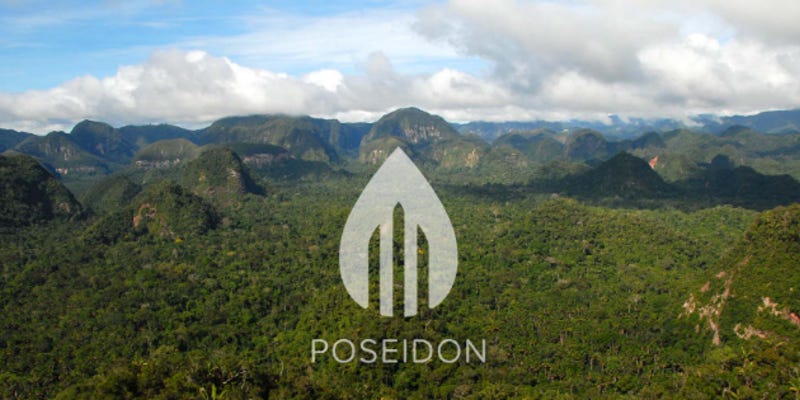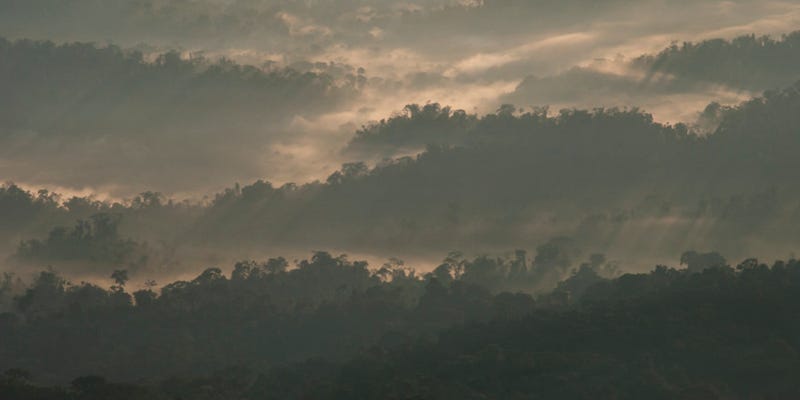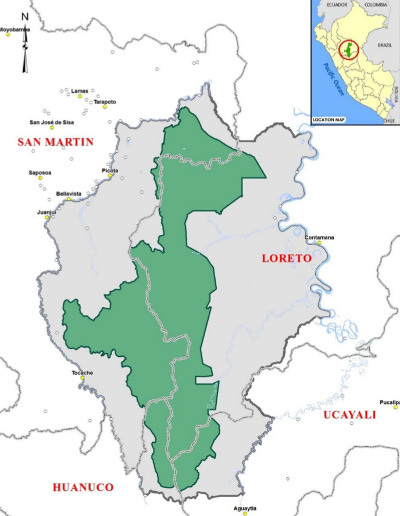Can buying Ben & Jerry’s ice cream save the Cordillera Azul National Park in Peru? Featuring Ecosphere+, Althelia, the Poseidon Foundation, REDD, Blockchain, and the government of Malta
Since May 2018, if you buy ice cream from Ben & Jerry’s Scoop Shop in Wardour Street, London, you will also buy a small part of a carbon credit. For every scoop of ice cream, a penny goes to buying carbon credits from the Cordillera Azul National Park REDD project in Peru.
This happens thanks to a partnership between Ben & Jerry’s and a company called the Poseidon Foundation.
The Poseidon Foundation is a not for profit organisation registered in Malta in March 2018. The Poseidon Foundation’s founder and CEO is a Swiss investment banker called Laszlo Giricz.
We’ll come back to the Poseidon Foundation, Giricz, and Malta later. First, here’s how Giricz explains the deal with Ben & Jerry’s:
“Once you’ve selected your ice cream, the rest is smooth sailing. You go up to the counter, and you’re being asked, ‘Hey, we have partnered with Poseidon and we are contributing one penny per scoop of ice cream towards forest conservation. Would you like to match that?’ And then it’s up to you to say, ‘That’s a great idea, I would like to give a penny.’ Or you say, ‘Ah, no I don’t feel like it.’ So it’s totally voluntary.
Or you can give more. Which is incredibly, exactly what’s happening. We witnessed fans of Ben & Jerry’s say, ‘£3.20 for a scoop of ice cream, make it four, round it up.’”
But the “really exciting part”, according to Giricz, is what happens next.
“We were able, with the blockchain technology and with the ability to transact in just 3 seconds, to create an integration that really is real time. So you go, you make a purchase, from the point of sale, 1p, 10p, pound, whatever you decide to give towards forest conservation, is immediately transacted through the point of sale to our backend, used to purchase tokens, we have a token called Ocean, and this Ocean token is then used to do a back to back transaction with the smart contract that holds the carbon credits.
“And what is really beautiful about this is that the customer, the consumer, who donated towards forest conservation, can see in real time on his mobile phone, ‘Hey, I just bought this product and service and I decided to contribute to forest conservation because I want to rebalance the climate impact of my product and service that I just purchased, and you know what, that money went towards this carbon credit, from this project, having this impact on the ground.’”
There are two new things here. First, buying the carbon credit is part of buying the ice cream (with the option of buying more carbon credits if you wish). Second, instead of buying a carbon credit to offset a ton of carbon, which is the usual unit for carbon credits, the Poseidon Foundation splits carbon credits into grams.
This is a very clever way of raising money for REDD. Who doesn’t like ice cream? No one wants to be told they shouldn’t eat ice cream by some vegan ecofreak (like me) because of the impact that cows have on climate change.
Ben & Jerry’s also has a target of reducing its emissions by 80% by 2020.
But is saving the rainforest really as simple as buying an ice cream?
The Cordillera Azul National Park REDD project
The forests of the Cordillera Azul National Park are spectacular and particularly worth saving. Covering 1.35 million hectares, the forests are habitat for a wide range of endangered species. An area in the southeast of the national park is a “strict protection zone”, an area where no one can enter, because of the possibility that non-contacted indigenous people from the Cacataibo group live in this area.
The government of Peru declared Cordillera Azul a national park in May 2001, nine months after a research team from The Field Museum in Chicago and The Peruvian Association for the Conservation of Nature (APECO) had carried out an inventory in the forests. They found dozens of species new to science.
In late 2000, APECO and The Field Museum partnered with Conservation International while they were preparing the documents need to establish the national park.
In 2002, a company called CIMA (Centro de Conservación, Investigación y Manejo de Áreas Naturales) signed an agreement with the government to manage the national park.
In August 2008, CIMA signed a 20-year Total Management Contract for the Cordillera Azul National Park. That was the start of the Cordillera Azul National Park REDD project.
In October 2008, Exelon Corporation, a US energy giant with annual revenues of US$33.5 billion, announced that it was donating US$1.5 million to The Field Museum. John W. Rowe chairman and CEO of Exelon said in a press statement that,
“In addition to the clear environmental benefits, our partnership will have strategic benefits to our business. Cordillera Azul National Park may serve as a model for the accurate measurement of carbon offsets from avoided deforestation. It is our hope that this voluntary protocol will be approved for use by others to meet legislative and regulatory requirements to reduce greenhouse gas emissions.”
In 2009, The Field Museum’s Debra Moskovits admitted that setting up a REDD project and selling carbon credits was a lot more complicated than she anticipated. “It’s all going to take a lot longer than I thought,” she said.
Enter Althelia
In November 2014, CIMA signed a Loan Agreement and Agency Agreement with Althelia Climate Fund, an investment fund registered in the tax haven of Luxembourg.
The contract with Althelia runs until at least 2021. Althelia provides an €8.55 million loan – that finances three-quarters of the operations of the national park and its buffer zone.
Between 2014 and 2017, the national park also received funding from USAID (through The Nature Conservancy), Blue Moon Fund, USAID, New Venture Fund, and Fondo de Las Americas.
The loan from Althelia will be repaid by selling eight million carbon credits to Althelia.
The involvement of Althelia in the Cordillera Azul National Park REDD project also brings in Ecosphere+ Limited, a company registered in the UK in September 2016. Ecosphere+ runs sales and marketing operations for Althelia’s portfolio of environmental assets.
Althelia Climate Fund was created by Sylvain Goupille and Christian del Valle, two investment bankers who previously worked at BNP Paribas Corporate and Investment Banking. Althelia Climate Fund is an unregulated collective investment scheme.
Althelia’s corporate structure is complicated. REDD-Monitor had a look at Althelia in 2016, but in October 2017, Althelia was taken over by Mirova S.A.
Ecosphere+ was originally owned by Althelia Climate Fund GP Sàrl, the Luxembourg registered company that manages the fund. That changed in September 2017, when another company owned by Althelia Climate Fund GP Sàrl, Ecosphere Capital Limited, bought Althelia Climate Fund GP Sàrl.
In September 2018, Ecosphere Capital Limited changed its name to Mirova Natural Capital Limited. The company is ultimately controlled by Mirova S.A., a Paris-based investment management company. Mirova S.A. owns 51% of the shares in Mirova Natural Capital Limited and exercises 51% of the voting rights over the company’s operations.
And Mirova S.A. is a subsidiary of Ostrum Asset Management, which until April 2018 was called Natixis Asset Management. Ostrum has €265.1 billion in assets under management.
REDD credits and Peru’s nationally determined contribution
In May 2018, Ecosphere+ put out a press release explaining that Althelia had come to an agreement with the Peruvian government about the inclusion of REDD in its nationally determined contribution, submitted to the UNFCCC in 2016.
Peru’s nationally determined contribution states that,
REDD+, as defined in the Warsaw framework and the related decisions, will be an important tool for the country to achieve its mitigation commitments, and there is the need to reinforce support for this mechanism under the new agreement.
Under the agreement with Althelia, the carbon credits generated between 2015 and 2018 will be deducted from Peru’s national inventory. After 2018, Althelia’s REDD projects in Peru (the other one is the Tambopata-Bahuaja Reserve REDD project) will be nested into the forest emissions reference level.
Exactly how the projects will be nested into Peru’s nationally determined contribution is not yet clear. Peru’s forests are facing serious threats. In 2017, according to Global Forest Watch, Peru lost 303,000 hectares of tree cover, equivalent to 32.9 million tons of CO2 emissions.
And the rate of tree loss is increasing:
In the past five years, small-scale gold mining has destroyed almost 70,000 hectares of primary rainforest in the Peruvian Amazon.
Threats to the Cordillera Azul National Park
While the 1.35 million hectares of the national park are currently well protected, the buffer zone of the national park faces ongoing threats. When Poseidon’s Laszlo Giricz talks about saving the rainforest by buying ice cream, and letting the blockchain do its magic, he does not mention the complexities faced by CIMA on the ground.
The most recent monitoring report for the REDD project available on the Verra website is for August 2015 to August 2016. The report lists the risks to the project. Number one on the list is the threat of climate change:
The predominant likely natural risk is the changing climate that will affect biodiversity and community and probably climate benefits as well during the project lifetime.
A 2017 study produced by CIMA found that in the last 30 years rainfall has decreased and the temperature has risen from 24°C to 26°C. There is a transition in some areas of tropical humid forests to dry forests.
Unfortunately, carbon trading does not reduce greenhouse gas emissions. While Ben & Jerry’s is not a major contributor to climate change (compared to, say, Shell), the aviation industry’s current plans to set up a carbon trading scheme would see massive increases in emissions from flying, and therefore a corresponding increase in the danger of runaway climate change.
The buffer zone of the national park covers an area of more than 2.3 million hectares. More than 350,000 people live adjacent to the national park.
A national road runs to the west of the national park, allowing migration and a steady increase in the number of people living in the buffer zone.
Most people living in the buffer zone do not own their land. While CIMA is working on land tenure issues with local communities, the monitoring report states that an “advancing agricultural frontier presents one of the most severe threats to the park as waves of immigrants advance their deforestation and erosion-provoking practices closer to and eventually into the park”.
In the past, the Peruvian government has handed out timber, mining and oil concessions in the buffer zone. Not all are active, but the concession holders have the legal right to use the land. “While these concessions are not inside the park, they pose a risk to the park,” the monitoring report notes.
Illegal activities in the buffer zone also threaten the national park, according to the monitoring report – drug trafficking, for example:
[I]n recent years the illegal activities such as drug trafficking has returned to proliferate in the forest. During the last period of verification, a landing strip was discovered in the buffer zone at the north of Contamana sector, so CIMA made coordination for closure, with the support of SERNANP and relevant institutions; in this occasion the security of parkguards and CIMA’s technicians could not be exposed to this risk.
From blockchain to artificial intelligence
Poseidon’s Laszlo Giricz explains why his company registered in Malta:
“We originally wanted to set up in Switzerland, and the government of Malta talked with us and said if you set up in Malta we would like to work with you on a pilot. Which we are now doing. So that’s very exciting.”
Malta is setting itself up as the world’s “blockchain island”. Last week, almost 8,500 people flew to Malta to take part in the Malta Blockchain Summit.
But Malta also has a reputation for corruption and a “a pirate base for tax avoidance inside the EU”. The Malta Files investigation exposed how large companies and wealthy private clients used Malta to dodge paying taxes.
A year ago, the Maltese investigative journalist Daphne Caruana Galizia was killed by a car-bomb. One of her investigations was into the Pilatus Bank. On 5 November 2018, the Bank was finally shut down by the European Central Bank over fraud charges.
In July 2018, Silvio Schembri, Malta’s Junior Minister for Financial Services, Digital Economy and Innovation, announced in parliament that a letter sent by the European Banking Association about institutional investigations into Pilatus Bank was only “routine”.
Hopefully, Schembri will do a better job of regulating Malta’s ambitions to become the world’s “blockchain island”. When Poseidon registered in Malta, Schembri said,
“The Maltese government is a global forerunner in regulating the operation of companies that work with digital technologies such as blockchain. We are thrilled to be working with Poseidon whose values firmly align with our own to truly address climate change meaningfully, through supporting projects that protect our planet.”
At the Malta Blockchain Summit, Schembri announced a task force to design a national strategy on artificial intelligence. The aim is to put Malta in the top ten countries in the world for artificial intelligence.
Bang on cue, as soon as the Malta Blockchain Summit was finished, Posiedon announced two artificial intelligence engines. Footprint-AI will produce carbon footprint analysis for products, services and organisations. Offset-AI will allow companies to set their preferences for carbon credits, so that their carbon credits come from the most “appropriate projects”.
This is part of Poseidon’s plan to expand its operations as quickly as possible. At the World Bank’s Innovate4Climate event in May 2018, in response to the question, “What’s next for Poseidon?”, Giricz replied,
“One word: scaling. Deforestation is such a stupid thing to do. I don’t know who came up with that idea. When you cut down trees in a forest you’re not only robbing the earth’s ability to cope with greenhouse gas emissions, but what you’re also doing is you’re releasing the carbon dioxide that has been captured in the trees back into the atmosphere because of course typically what happens in the deforestation is that people cut down trees and they burn them. And in rainforests, you have trees up to one thousand years, the average age of a tree in a mature rainforest is about 400 years, so you’re burning that and you’re releasing 400 years of carbon capture back into the atmosphere. It’s ridiculous.”
The contradiction of rich people sitting in a conference venue in central Europe, the majority having burned large amounts of fossil fuels to get there by flying, is apparently lost on Giricz. As is the fact that the carbon in fossil fuels has been safely stored underground for millions of years.
Giricz continues,
“So we’re very excited about what we’re doing next with Poseidon, and that’s really scaling. As I mentioned earlier, we’re live with Ben & Jerry’s in London, which is very exciting. And in the three weeks we’ve been live so far, which was really a soft launch, we haven’t done any press announcements, there’s going to be a press announcement this week, we waited to see first three weeks of pilot, we wanted to see how the people react to it, now we’re very confident to go out into the public with it.
“But over three weeks, without media, without any sign boards in the shop, without anyone actually knowing what’s happening until they came to the till, we’ve already protected about 1,200 trees and an area that’s equivalent to about 78 tennis courts.
“That’s with one shop. So the next step for us is scaling. Ben & Jerry’s are already talking to us about scaling this to the hundreds of shops they have around the world, and you can image what impact that has, especially with the right media and with the right education, this really can have a global impact.”
Giricz’s comment about protecting 78 tennis courts is just nonsense. Althelia has given a loan of €8.55 million for CIMA to run the national park and work with communities in the buffer zone.
The money from Ben & Jerry’s ice cream sales will end up in the deep pockets of Althelia’s owners, as the loan is repaid. What we don’t know is how much Althelia is charging Ben & Jerry’s for the carbon credits that it bought for a little over €1 each.
As with all REDD projects, there is an unnecessary level of complexity in the funding arrangement, along with opportunities for a small army of financiers, auditors, and consultants to cash in along the way.
If Ben & Jerry’s is really serious about protecting rainforests, wouldn’t it make more sense for the company to cut out the intermediaries (Poseidon, Althelia, Ecoshpere+, Verra, CCBA, TerraCarbon, etc.) and give its money directly to CIMA to protect the Cordillera Azul National Park?








